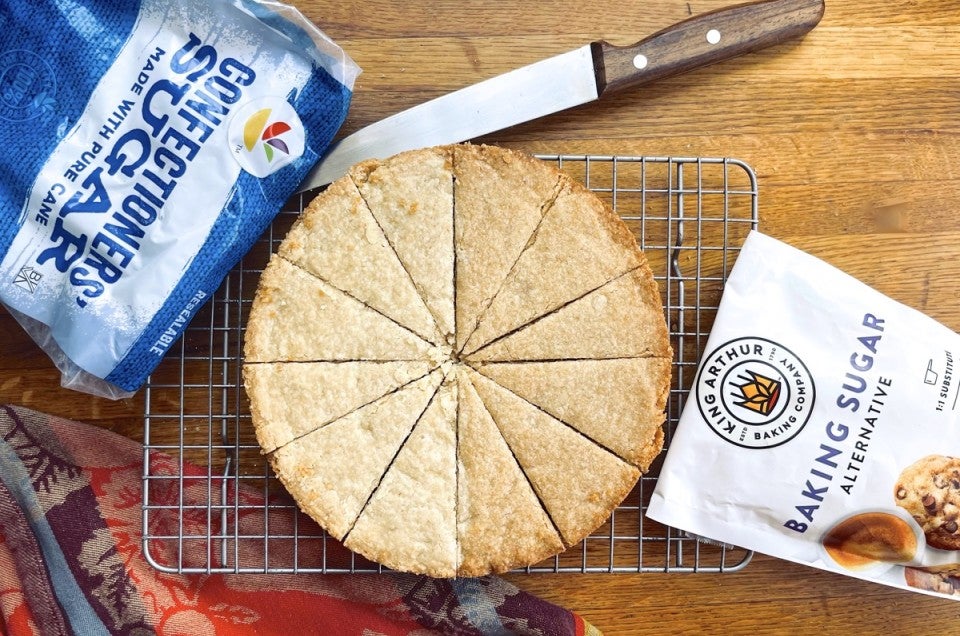How to sub Baking Sugar Alternative for brown sugar or confectioners' sugar
Ditch the sugar — keep the sweetness.


Many of us these days are trying to cut back on our sugar intake — but that doesn’t mean we don’t crave something sweet at the end of a meal! It’s a conundrum, isn’t it?
Here at King Arthur we’ve recently launched a “sweet-not-sugary” initiative, showcasing sensible ways to reduce the amount of added sugar in your favorite baked treats and highlighting which desserts deliver big flavor without lots of sugar calories.
Most exciting to me has been finding more and more ways to use our new Baking Sugar Alternative (BSA), launched in 2020. Made from erythritol (a naturally occurring sugar alcohol) and including both monk fruit and stevia extracts, I regularly substitute BSA in many of my favorite recipes with absolutely no drop-off in either flavor or texture.
Until now I’d focused mostly on the easy cup-for-cup substitution of BSA for granulated cane sugar. But what about brown sugar and confectioners’ sugar, two regulars in any dessert baker’s pantry — is it just as simple to swap those out for BSA?
Let’s find out.
This is an easy substitute; you can transform BSA into “brown sugar” the exact same way you turn cane sugar into brown sugar.
The typical processed brown sugar you buy at the supermarket is simply granulated sugar mixed with a bit of molasses for color and caramel-like flavor. So to use BSA in place of brown sugar, make the usual 1:1 substitute (by volume, not weight) for the granulated sugar in your recipe: e.g., if your recipe calls for 1 cup of granulated sugar, replace it with 1 cup of BSA.
Next, add molasses; you don’t have to combine it with the BSA, simply stir it into the bowl along with any liquid ingredients you’re using. To substitute for light brown sugar, add 2 teaspoons (14g) molasses per cup of sugar called for; for dark brown sugar, add 1 tablespoon (21g) molasses. (Don’t sweat the extra liquid molasses brings to the recipe; trust me, it’ll prove insignificant.)
Although you may be wary of adding even this small amount of molasses (“real” sugar) to your recipe, it can be important. Since brown sugar (and molasses) are acidic, and acidity helps with leavening (and affects spread in cookies), leaving out the molasses could result in your recipe turning out just slightly different than the original. Still, if you’re dead set against molasses — leave it out. Your cookies, muffins, bars, and cake will be just fine.
One caveat: In bar recipes where brown sugar is the only (or main) sweetener, it contributes moist, chewy texture as well as flavor and sweetness (e.g., these Loaded Chocolate Chip Blondies, which call for 2 cups of brown sugar). BSA won’t replicate that signature texture, yielding something lighter instead: think cakey brownie rather than fudgy brownie. Your bars made with BSA will still be tasty; just not ooey-gooey dense-and-moist.
Conclusion: Baking Sugar Alternative + molasses is a simple and effective substitute for brown sugar in most baked goods.
First, a short (but sweet) science lesson. If you’ve used other sugar alternatives in the past, you may have their noticed their unpleasant “cool”/metallic aftertaste. This is from erythritol, which absorbs energy from its surroundings as it dissolves; when the surroundings are your mouth, this energy absorption manifests as an odd menthol-like taste.
Thankfully, our BSA is known for its great taste; when used in baking, you’ll never notice anything “off” with your baked goods’ flavor. However, when BSA is consumed “raw” — e.g., the erythritol hasn’t been dissolved either by baking, or by heating in liquid — it’s possible some people may sense a bit of coolness. For this reason, you may not want to substitute BSA for confectioners’ sugar in unbaked fillings, frostings, and toppings. (One exception: frosting recipes where the BSA is heated in liquid first, such as this Swiss Buttercream Frosting.)
So, how do you do it — is BSA a simple 1:1 substitute for confectioners’ sugar?
Not quite. Granulated sugar, brown sugar, and BSA are all a similar granulation: Their crystal size is basically equivalent. Not so confectioners’ sugar, which is a much finer grind and also includes a touch of cornstarch to prevent caking.
To account for the two sugars’ different granulation sizes, substitute an equal amount of BSA for confectioners’ sugar by weight instead of volume: e.g., if your recipe calls for 1 cup (113g) of confectioners’ sugar, use 113g of BSA. If you don’t have a scale, substitute two-thirds the amount of BSA by volume: e.g., substitute 2/3 cup BSA for 1 cup confectioners’ sugar. Oh, and don’t worry about adding any cornstarch: Its absence won’t be noticed.
Conclusion: Baking Sugar Alternative may be substituted 1:1 (by weight, not volume) for confectioners' sugar in most recipes, the exception being recipes that don't involve heating the sugar to dissolve it (e.g., most frostings and glazes).
Hopefully by now you’ve experienced for yourself how nicely Baking Sugar Alternative steps in for granulated sugar. So don’t be shy about reaching for BSA when your recipe calls for brown sugar — or when it uses confectioners’ sugar as part of the bake rather than as a topping. In test after test, BSA has proven itself the best all-purpose low-carb, calorie- and keto-friendly alternative to your traditional sweeteners. Who could ask for anything more?
Check out the all delicious ways bakers across the country are using BSA: Why bakers are making the switch to Baking Sugar Alternative.
Cover photo by PJ Hamel.